What is Blood?
Blood is more than just a red fluid coursing through our veins. It is a fluid connective tissue with varied roles, from carrying oxygen and nutrients to defending our body against infections. In this detailed guide, you will learn what is blood, its structure, the composition of blood, blood cell types, and the function of blood in the human body. We will also discuss the formation of blood and highlight some unique facts not commonly covered elsewhere. By the end of this page, you will have a thorough understanding of why blood is vital to life.
Read More: Tissues
Introduction:
Blood circulates through our body, delivering oxygen and vital nutrients to cells and carrying away carbon dioxide and other wastes. It makes up about 7-8% of the total body weight in a healthy adult, and an average adult typically has around 5-6 litres of blood.
Despite appearing as a single uniform fluid, blood is made of multiple components, each with its special role. We often depict blood as “red,” but its colour and characteristics depend on a unique protein called haemoglobin, as well as other dissolved components.
Structure of Blood
When discussing the structure of blood, we mean the physical and organisational aspects of its components. Blood moves within a closed circulatory system comprising the heart and an extensive network of blood vessels (arteries, veins, and capillaries). Within this system:
Red Blood Cells (RBCs), packed with haemoglobin, transport oxygen to tissues.
White Blood Cells (WBCs) defend against infection.
Platelets, also called thrombocytes, help in clot formation.
The liquid medium, plasma, carries nutrients, hormones, and other essential substances.
Composition of Blood
One of the most critical aspects of understanding blood is grasping the composition of blood. Essentially, blood consists of two main parts:
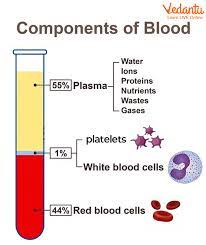
A blood diagram often shows the relative proportions of these components, highlighting that blood is about 55% plasma and 45% formed elements of blood (RBCs, WBCs, and platelets).
Plasma (about 55%)
Water: Forms the bulk of plasma (around 90-92%).
Proteins: Such as fibrinogen, albumin, and globulins.
Solutes: Including electrolytes (salts), nutrients (glucose, amino acids), gases, hormones, and waste products.
Formed Elements of Blood (about 45%)
Red Blood Cells (RBCs) or Erythrocytes: These biconcave, disc-shaped cells contain haemoglobin.
White Blood Cells (WBCs) or Leucocytes: The “soldiers” of the immune system.
Platelets (Thrombocytes): Tiny fragments essential for blood clotting.
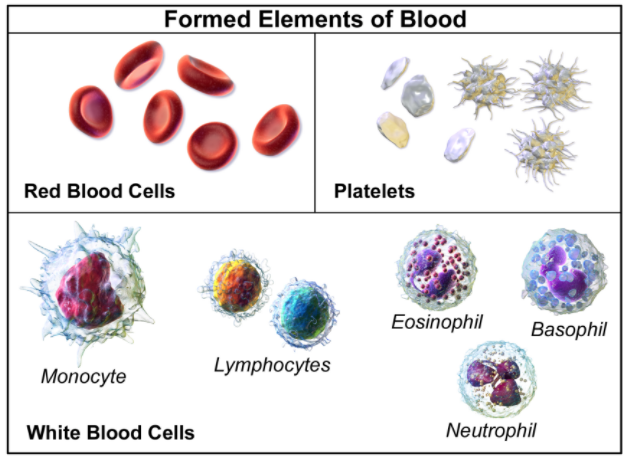
By separating a sample of blood in a centrifuge, these components are segregated into distinct layers: plasma (top), a thin buffy coat (WBCs and platelets), and RBCs (bottom). Recognising the composition of blood clarifies how blood is both a transport system and an active participant in immunity.
Read More: Difference Between Plasma and Serum
Blood Cells Types
A deeper look into the blood cell types reveals their specialised roles. Blood consists of three main types of cells:
1. Red Blood Cells (Erythrocytes)
Shape and Structure: RBCs are biconcave discs without a nucleus in humans.
Function: Primary carriers of oxygen (via haemoglobin) and carbon dioxide.
Lifespan: Approximately 120 days, after which they are broken down primarily in the spleen.
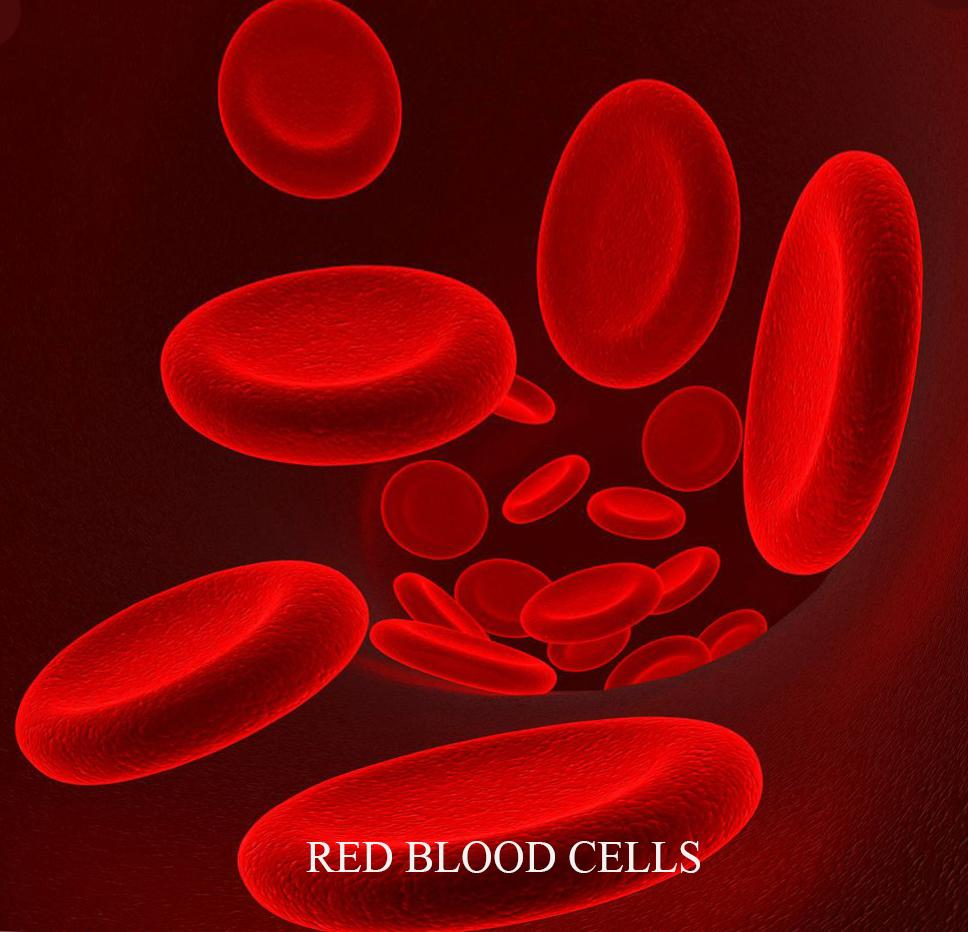
2. White Blood Cells (Leucocytes)
Function: Major players in immune defence, fighting infections from bacteria, viruses, and other pathogens.
Types of WBCs:
Granulocytes (with visible granules in the cytoplasm):
Neutrophils: The most abundant WBCs, crucial for phagocytosing bacteria.
Eosinophils: Combat parasitic infections and help regulate allergic responses.
Basophils: Release histamine and heparin, significant in inflammation and allergic reactions.
Agranulocytes (lack visible granules in the cytoplasm):
Monocytes: Mature into macrophages in tissues and clean up cellular debris.
Lymphocytes: Include B-lymphocytes and T-lymphocytes, vital for adaptive immunity and antibody production.
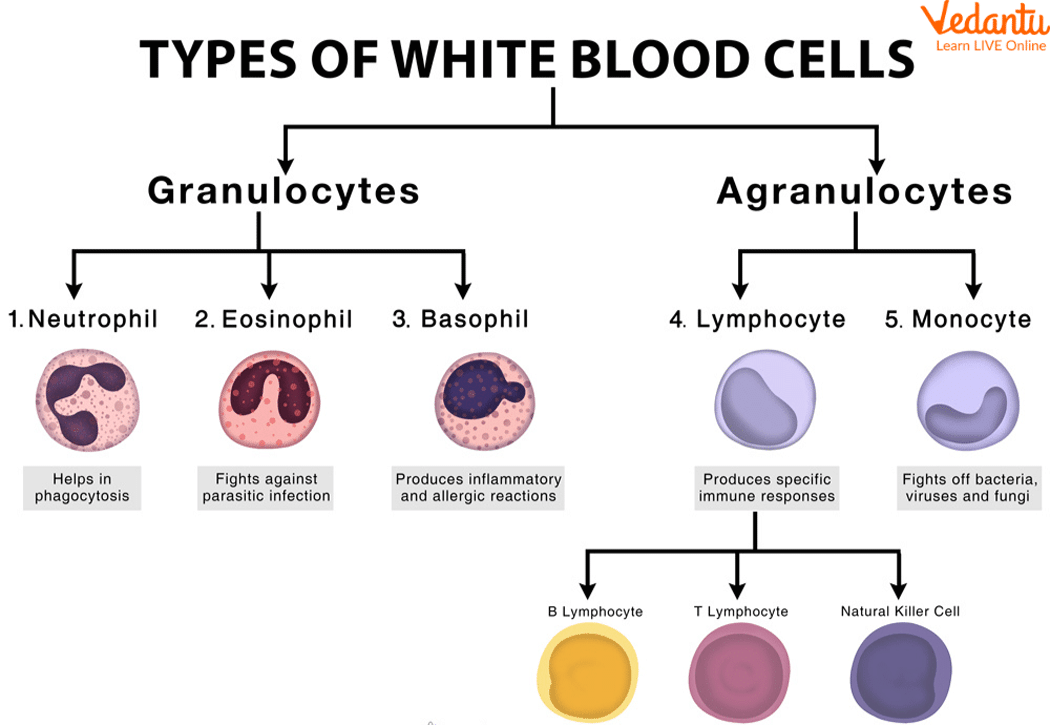
3. Platelets (Thrombocytes)
Appearance: Tiny, disc-like fragments derived from megakaryocytes in the bone marrow.
Main Function: Assist in clotting and coagulation, forming plugs at wound sites to prevent blood loss.
Formation of Blood (Haematopoiesis)
The formation of blood, scientifically called haematopoiesis, occurs primarily in the red bone marrow (found in bones such as the sternum, ribs, and pelvis). Stem cells in the bone marrow differentiate into various blood cell types—RBCs, WBCs, and platelets—under the influence of specific growth factors.
Key Steps in Haematopoiesis
Pluripotent Stem Cells: The origin of all blood cells.
Commitment to Lineages: Some become myeloid stem cells (leading to RBCs, platelets, granulocytes, and monocytes), while others become lymphoid stem cells (leading to lymphocytes).
Maturation: Cells develop the unique characteristics needed for their final function (e.g., RBCs fill with haemoglobin, and lose their nucleus).
Release into Circulation: Mature cells enter the bloodstream, ready to perform the function of blood in the human body.
Understanding the formation of blood is crucial for comprehending various disorders like anaemia (reduced RBC production), leukopenia (low WBC count), and thrombocytopenia (low platelet count).
Also Check: Difference Between Blood and Lymph
The Function of Blood in the Human Body
What exactly is the function of blood in the human body? Broadly, it can be divided into the following key roles:
Transportation
Oxygen and Carbon Dioxide: RBCs carry oxygen from the lungs to tissues and bring back carbon dioxide to the lungs for exhalation.
Nutrients and Waste: Blood carries glucose, amino acids, vitamins, and minerals to cells while removing metabolic wastes like urea.
Hormones: Endocrine glands release hormones directly into the bloodstream for delivery to target organs.
Regulation
Temperature: Blood helps distribute heat throughout the body and assists in thermoregulation.
pH and Fluid Balance: Plasma contains buffers to maintain pH balance; it also regulates fluid and electrolyte balance.
Protection
Immune Defence: WBCs identify and destroy pathogens.
Blood Clotting: Platelets and clotting factors prevent excessive blood loss from injuries.
By fulfilling these functions, blood ensures the survival and efficient operation of every tissue and organ. Though these are often summarised as the main function of blood, the detail above shows how multifaceted these roles can be.
Blood Vessels
Blood doesn’t simply exist in isolation; it is transported through an intricate network of blood vessels:
Arteries
Carry oxygen-rich blood away from the heart.
Their walls are thick and elastic to withstand high pressure.
Veins
Return deoxygenated blood to the heart.
Thinner walls often contain valves to prevent backflow.
Capillaries
Microscopic vessels where exchange of gases, nutrients, and waste occurs.
Connect the arterial and venous systems.
Additionally, sinusoids are specialised, wider capillaries in organs like the liver and spleen, allowing efficient exchange of larger molecules or even cells.
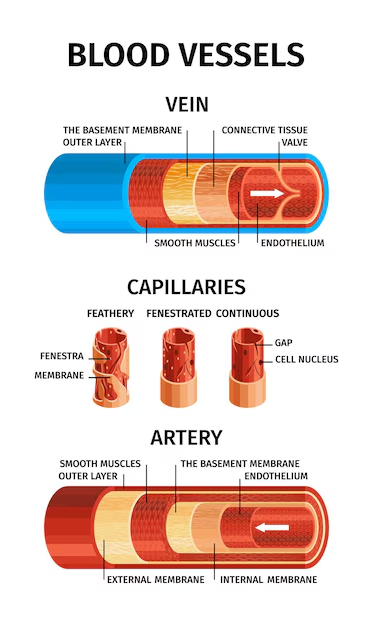
Additional Unique Facts about Blood
Here are a few unique tidbits to make our content stand out from the rest:
Role of Erythropoietin (EPO): A hormone primarily produced by the kidneys that stimulates the formation of blood cells, especially RBCs. It responds to low oxygen levels, signalling the bone marrow to produce more RBCs.
Unique Vertebrate without Haemoglobin: The Antarctic icefish lacks haemoglobin, relying on the oxygen-rich cold waters for its survival—an exception among vertebrates.
Blood Groups and Transfusion: Beyond the well-known ABO system, there are dozens of lesser-known blood group systems such as Rh, Kell, and Duffy. Proper blood typing is crucial to avoid transfusion reactions.
Colour Variations in Other Organisms: While human blood is red due to haemoglobin, some organisms have different-coloured blood: for instance, many arthropods have blue blood due to a copper-based molecule called haemocyanin.
White Blood Cell Lifespan: Unlike RBCs, some WBCs (like certain memory lymphocytes) can live for years, offering long-term immunity after infections or vaccinations.
Related Links:


FAQs on Blood: Structure, Composition, and Vital Functions
1. What is blood and why is it considered a fluid connective tissue?
Blood is a specialised body fluid comprising plasma and formed elements of blood (RBCs, WBCs, platelets). The cells are suspended in a liquid matrix, which is why it is categorised as connective tissue.
2. How does the structure of blood relate to its functions?
The structure of blood—comprising plasma, RBCs, WBCs, and platelets—enables it to transport oxygen, defend against infections, and clot injuries swiftly.
3. What do we mean by ‘blood consists of’ plasma and formed elements?
This phrase indicates that the major parts of blood are a fluid component (plasma) and cellular elements (RBCs, WBCs, and platelets).
4. Why are red blood cells important in humans?
RBCs contain haemoglobin, crucial for carrying oxygen to tissues and removing carbon dioxide. They form a significant part of the main function of blood, which is transport.
5. How many blood cell types are there?
Broadly, there are three main blood cell types: RBCs, WBCs, and platelets. WBCs further split into granulocytes (neutrophils, eosinophils, basophils) and agranulocytes (monocytes, lymphocytes).
6. What is the formation of blood called?
The formation of blood is termed haematopoiesis, which largely takes place in the red bone marrow.
7. Can I see a blood diagram for a better understanding?
A blood diagram typically illustrates plasma on top, a buffy coat of WBCs and platelets in the middle, and RBCs at the bottom when blood is centrifuged. It highlights the layered structure and helps visualise the composition of blood.
8. What is the function of blood in the human body?
The function of blood in the human body includes the transport of gases, nutrients, hormones, and waste products; temperature regulation; and protection against pathogens and blood loss.
9. Which organs help in removing old or damaged RBCs?
The spleen is often called the “RBC graveyard” as it helps filter and break down old RBCs. The liver also contributes by removing toxins released from RBC breakdown.
10. Why does blood need to maintain a specific pH range?
Most biochemical reactions occur optimally at a near-neutral pH (7.35-7.45). Blood ensures this balance through buffers in plasma, maintaining homeostasis.










